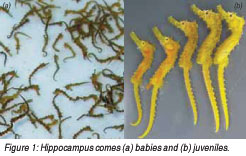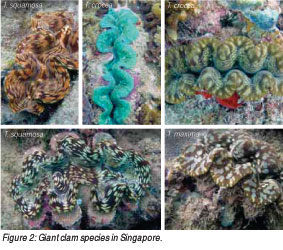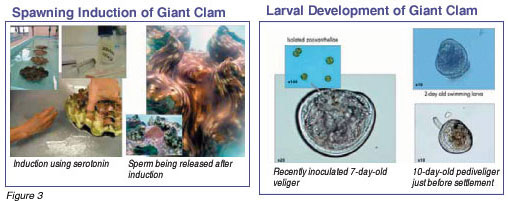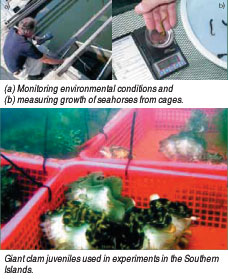|
by Konda P REDDY, Juan WALFORD, B SIVALOGANATHAN, and James GUEST
 n the Indo-Pacific region, seahorse populations are rapidly dwindling mainly due to the brisk trade of the unique creatures for traditional Chinese medicine (TCM) and aquariums. The global trade in seahorses for TCM and aquarium trade is estimated at more than 20 million seahorses every year. n the Indo-Pacific region, seahorse populations are rapidly dwindling mainly due to the brisk trade of the unique creatures for traditional Chinese medicine (TCM) and aquariums. The global trade in seahorses for TCM and aquarium trade is estimated at more than 20 million seahorses every year.
Giant clams face a similar fate precipitated by the demand for adductor muscle and mantle for food, shells for ornaments, and live clams for the aquarium. Some species have been rendered virtually extinct in parts of Asia (e.g. the Philippines) because of unregulated harvesting.
To make matters worse, degradation of the coastal environments and reefs has contributed to the depletion of natural habitats of both these fragile marine animals. In many places, loss of habitat poses a bigger threat than the effects of global trade. Some recent studies have shown that the populations of seahorses and giant clams in Singapore waters have been much reduced compared to earlier surveys.
Thus a dire need exists for conservation of seahorses and giant clams. In addition to the conservation and scientific interest of the two creatures, there is another practical reason for their importance.
 They serve as environmental indicators, which are invaluable in assuring the quality of the marine environment in Singapore coastal waters. Seahorses do not move very far and attach themselves using their prehensile tails; giant clams by nature cannot move; therefore both species are unable to move away in response to deteriorating environmental conditions. By monitoring the well-being of such sedentary species and the environmental conditions in their habitats, the collected data can provide essential information, which together with other coastal water monitoring data may be able to offer a more complete understanding of the marine environment and about how coastal environmental conditions affect marine life. They serve as environmental indicators, which are invaluable in assuring the quality of the marine environment in Singapore coastal waters. Seahorses do not move very far and attach themselves using their prehensile tails; giant clams by nature cannot move; therefore both species are unable to move away in response to deteriorating environmental conditions. By monitoring the well-being of such sedentary species and the environmental conditions in their habitats, the collected data can provide essential information, which together with other coastal water monitoring data may be able to offer a more complete understanding of the marine environment and about how coastal environmental conditions affect marine life.
A group of marine biologists at the National University of Singapore's Tropical Marine Science Institute (TMSI) on St John's Island have succeeded in developing a new hatchery technology for producing the young of local seahorses and giant clams regularly in relatively large numbers, as well as using them as environmental indicators to monitor the coastal waters around Singapore island.
By surveying various locations around Singapore coastal waters, the scientists found only two species of seahorses -- Hippocampus comes and H. kuda -- in low numbers. As a step towards producing young seahorses for use in environmental studies (see box story) and to select suitable sites for stock enhancement, they developed hatchery technology for production of juveniles of both species.
 After many rearing trials, the researchers achieved a major breakthrough when they identified the natural organisms from Singapore coastal waters essential for initiating feeding in the baby seahorses. They established that at first feeding, local seahorse babies cannot be reared using Artemia (brine shrimp) larvae as reported in Australia and New Zealand; they need to feed on natural plankton for at least 10 days. Based on this success in rearing baby seahorses, the TMSI team has been able to achieve regular production of seahorse juveniles for the first time in Singapore on St John's Island with survival rates of more than 70% for both local species up to two months old (Figure 1). After many rearing trials, the researchers achieved a major breakthrough when they identified the natural organisms from Singapore coastal waters essential for initiating feeding in the baby seahorses. They established that at first feeding, local seahorse babies cannot be reared using Artemia (brine shrimp) larvae as reported in Australia and New Zealand; they need to feed on natural plankton for at least 10 days. Based on this success in rearing baby seahorses, the TMSI team has been able to achieve regular production of seahorse juveniles for the first time in Singapore on St John's Island with survival rates of more than 70% for both local species up to two months old (Figure 1).
Surveys confirmed that only three species of giant clams exist in the waters of Singapore's Southern Islands -- Tridacna squamosa, T. maxima, and T. crocea (Figure 2). However, their numbers are insufficient to maintain future balanced recruitment and the investigators found no juvenile clams that could ensure the continuation of the local populations.
As a result of spawning and rearing of giant clams for the first time in Singapore, the biologists are able to produce sufficient giant clam juveniles to monitor environmental conditions in the Southern Islands (see box story) and to undertake a future stock enhancement programme to ensure that the limited population can be maintained and possibly even increased.
 The researchers induced giant clams in tanks to release eggs and sperm; they then studied the development of the eggs and larvae (Figure 3). At the free swimming stage, they infected the larvae with zooxanthellae, symbiotic algae, then let the larvae settle on the bottom of the tanks. At about six or seven months, the team transferred the clam juveniles to reef sites for environmental studies. With their deep understanding of the life cycle of the creature, the researchers have successfully achieved regular spawning and settlement of local giant clams and produced a few thousand juvenile clams at each spawning. The researchers induced giant clams in tanks to release eggs and sperm; they then studied the development of the eggs and larvae (Figure 3). At the free swimming stage, they infected the larvae with zooxanthellae, symbiotic algae, then let the larvae settle on the bottom of the tanks. At about six or seven months, the team transferred the clam juveniles to reef sites for environmental studies. With their deep understanding of the life cycle of the creature, the researchers have successfully achieved regular spawning and settlement of local giant clams and produced a few thousand juvenile clams at each spawning.
|
Living Environmental Indicators
 In a new initiative to study the waters around Singapore, TMSI researchers use seahorses as living indicators of the marine environment. The 29 June, 2006, issue of Nature highlighted this work in the news feature entitled "Science on the Solstice". The team placed cages with seahorse juveniles in selected sites on the east, south, and west coasts of the island. They monitored the animals' growth and survival over six months in order to track the environmental conditions and to select suitable areas for stock enhancement. They recorded the reproductive status of the groups of seahorses in each cage in terms of maturity, sex ratio, and the percentage of pregnant males at each weekly sampling. In a new initiative to study the waters around Singapore, TMSI researchers use seahorses as living indicators of the marine environment. The 29 June, 2006, issue of Nature highlighted this work in the news feature entitled "Science on the Solstice". The team placed cages with seahorse juveniles in selected sites on the east, south, and west coasts of the island. They monitored the animals' growth and survival over six months in order to track the environmental conditions and to select suitable areas for stock enhancement. They recorded the reproductive status of the groups of seahorses in each cage in terms of maturity, sex ratio, and the percentage of pregnant males at each weekly sampling.
The teams carried out similar experiments using the giant clam juveniles. The results of these environmental studies have enabled the scientists to identify suitable areas for stock enhancement of the two marine animals -- the vicinity of Pulau Ubin for carrying out stock enhancement with juvenile seahorses and several sites in the Southern Islands for giant clam juveniles.
The researchers' regular monitoring of the sites of the seahorses and giant clams revealed some special conditions that characterise these coastal areas and the rapid changes that can take place in the coastal environment. They believe that this data is important in complementing the environmental monitoring being carried out in more offshore areas around Singapore. This data can also be applied to the selection of sites suitable for growth and survival of seahorses and giant clams in Singapore coastal waters.
|
 Click here to download the full issue for USD 6.50 Click here to download the full issue for USD 6.50
|


 n the Indo-Pacific region, seahorse populations are rapidly dwindling mainly due to the brisk trade of the unique creatures for traditional Chinese medicine (TCM) and aquariums. The global trade in seahorses for TCM and aquarium trade is estimated at more than 20 million seahorses every year.
n the Indo-Pacific region, seahorse populations are rapidly dwindling mainly due to the brisk trade of the unique creatures for traditional Chinese medicine (TCM) and aquariums. The global trade in seahorses for TCM and aquarium trade is estimated at more than 20 million seahorses every year.
 They serve as environmental indicators, which are invaluable in assuring the quality of the marine environment in Singapore coastal waters. Seahorses do not move very far and attach themselves using their prehensile tails; giant clams by nature cannot move; therefore both species are unable to move away in response to deteriorating environmental conditions. By monitoring the well-being of such sedentary species and the environmental conditions in their habitats, the collected data can provide essential information, which together with other coastal water monitoring data may be able to offer a more complete understanding of the marine environment and about how coastal environmental conditions affect marine life.
They serve as environmental indicators, which are invaluable in assuring the quality of the marine environment in Singapore coastal waters. Seahorses do not move very far and attach themselves using their prehensile tails; giant clams by nature cannot move; therefore both species are unable to move away in response to deteriorating environmental conditions. By monitoring the well-being of such sedentary species and the environmental conditions in their habitats, the collected data can provide essential information, which together with other coastal water monitoring data may be able to offer a more complete understanding of the marine environment and about how coastal environmental conditions affect marine life.
 After many rearing trials, the researchers achieved a major breakthrough when they identified the natural organisms from Singapore coastal waters essential for initiating feeding in the baby seahorses. They established that at first feeding, local seahorse babies cannot be reared using Artemia (brine shrimp) larvae as reported in Australia and New Zealand; they need to feed on natural plankton for at least 10 days. Based on this success in rearing baby seahorses, the TMSI team has been able to achieve regular production of seahorse juveniles for the first time in Singapore on St John's Island with survival rates of more than 70% for both local species up to two months old (Figure 1).
After many rearing trials, the researchers achieved a major breakthrough when they identified the natural organisms from Singapore coastal waters essential for initiating feeding in the baby seahorses. They established that at first feeding, local seahorse babies cannot be reared using Artemia (brine shrimp) larvae as reported in Australia and New Zealand; they need to feed on natural plankton for at least 10 days. Based on this success in rearing baby seahorses, the TMSI team has been able to achieve regular production of seahorse juveniles for the first time in Singapore on St John's Island with survival rates of more than 70% for both local species up to two months old (Figure 1).
 The researchers induced giant clams in tanks to release eggs and sperm; they then studied the development of the eggs and larvae (Figure 3). At the free swimming stage, they infected the larvae with zooxanthellae, symbiotic algae, then let the larvae settle on the bottom of the tanks. At about six or seven months, the team transferred the clam juveniles to reef sites for environmental studies. With their deep understanding of the life cycle of the creature, the researchers have successfully achieved regular spawning and settlement of local giant clams and produced a few thousand juvenile clams at each spawning.
The researchers induced giant clams in tanks to release eggs and sperm; they then studied the development of the eggs and larvae (Figure 3). At the free swimming stage, they infected the larvae with zooxanthellae, symbiotic algae, then let the larvae settle on the bottom of the tanks. At about six or seven months, the team transferred the clam juveniles to reef sites for environmental studies. With their deep understanding of the life cycle of the creature, the researchers have successfully achieved regular spawning and settlement of local giant clams and produced a few thousand juvenile clams at each spawning.
 In a new initiative to study the waters around Singapore, TMSI researchers use seahorses as living indicators of the marine environment. The 29 June, 2006, issue of Nature highlighted this work in the news feature entitled "Science on the Solstice". The team placed cages with seahorse juveniles in selected sites on the east, south, and west coasts of the island. They monitored the animals' growth and survival over six months in order to track the environmental conditions and to select suitable areas for stock enhancement. They recorded the reproductive status of the groups of seahorses in each cage in terms of maturity, sex ratio, and the percentage of pregnant males at each weekly sampling.
In a new initiative to study the waters around Singapore, TMSI researchers use seahorses as living indicators of the marine environment. The 29 June, 2006, issue of Nature highlighted this work in the news feature entitled "Science on the Solstice". The team placed cages with seahorse juveniles in selected sites on the east, south, and west coasts of the island. They monitored the animals' growth and survival over six months in order to track the environmental conditions and to select suitable areas for stock enhancement. They recorded the reproductive status of the groups of seahorses in each cage in terms of maturity, sex ratio, and the percentage of pregnant males at each weekly sampling.
 Click here to download the full issue for USD 6.50
Click here to download the full issue for USD 6.50